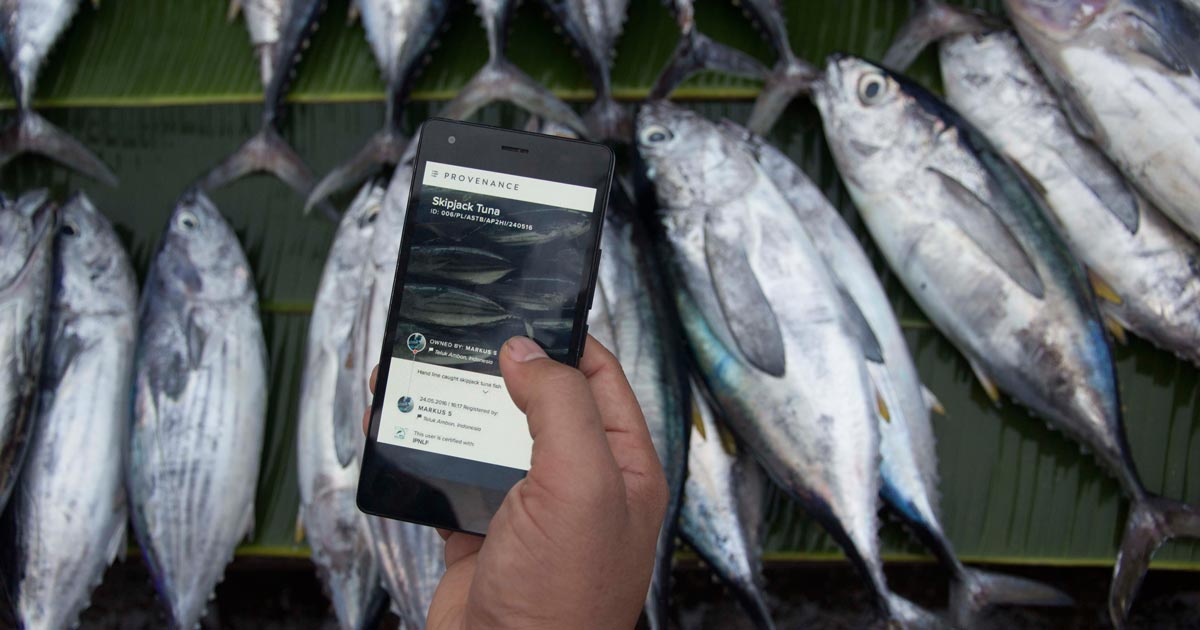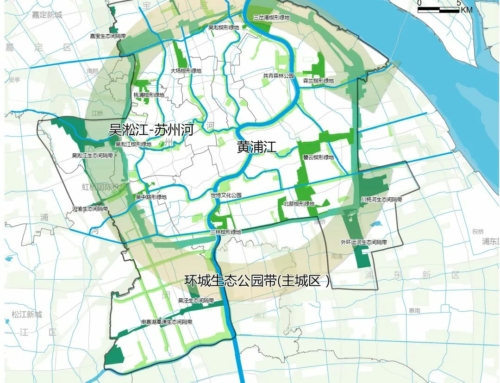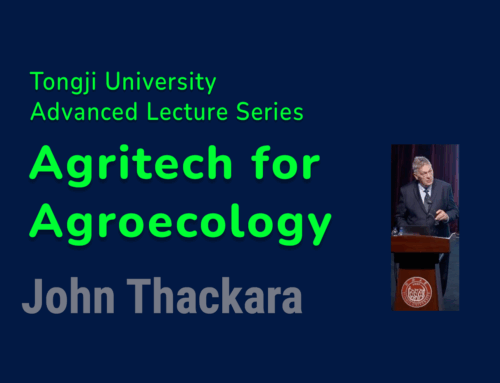The following interview with Valentina Croci appears in the March 2018 special edition on innovation of Domus magazine . The print edition is in Italian and English, but does not include all the illustrations I’ve used here).
Q1 The consumerist model and our fossil resources have been stretched to their limits. What could be an alternative model of production?
Innovation can help us reign in the over-extraction of resources. This seafood tracing platform is being developed by @provenance
JT I’ve come to an inconvenient conclusion: production is not the purpose of life. I say inconvenient because many of us depend on industrial production, and its many support services, to earn the money we need to pay for daily life needs. But because the global economy has to grow just to survive, its hunger for energy and materials is insatiable. The growing complexity of it all is resource-hungry, too — think of all those interconnected global supply chains.
This conflict between a perpetual growth economy, and the biophysical limits of a living planet, is why the perpetual search for new forms of production – whether ‘clean’, ‘green’ or ‘circular’ – is not where our future lies
Our future lies in a care-based economy that embodies a commitment to leave things better rather than extract value from the world as quickly as possible.
The good news is that a huge care economy already exists. So-called ‘non-market’ care work includes the essential activity people have always undertaken to raise and educate their families, take care of their land, and support each other in times of difficulty. Billions of people with low cash incomes meet daily life needs outside the money economy through traditional networks of reciprocity and gifts. They survive, and often prosper, within social systems based on kinship, sharing, and myriad ways to share resources.
In this parallel real world value arises from relationships., not from things. Value emerges when living entities – whether human beings, or living ecosystems – interact with each other in a healthy way.
Redirecting our attention from production, to care, is a matter of discovery, not invention. Millions of small-scale experiments, and new ways to meet daily life needs, are emerging throughout the world. The opportunity before us is to seek out these projects, and develop practical ways to help these new approaches thrive, and interconnect.
The physicist Ilya Prigogine put it beautifully. “When a system is far from equilibrium, small islands of coherence have the capacity to shift the entire system”.
So that’s our priority now: develop islands of coherence in our own situation – and connect with other islands when the need arises.
Q2 Design is proposing a new definition of ecology: civic ecology. Can you explain the concept?
The French company Natural Solutions develops apps like EcoBalade (above) that help citizens identify plants and other life-forms.
JT In the new economy that’s now emerging, care for life replaces our a preoccupation with money. Value is measured in terms of the health of living systems, and the land, air, and oceans that surround us.
Cities, in this context, are part of the natural world, not outside it. Civic ecology – also known as ecological urbanism – has emerged in response to this understanding of life as the ultimate value.
An ecological approach to the design of cities builds on some surprisingly good news. It turns out that there can be more biodiversity in cities than in cultivated rural areas that we think about as ‘nature’. Researchers who investigate disused industrial areas, rail yards, the edge of motorways, brownfield sites of all kinds, are finding all kinds of plants and beetles, insects, lichen, and other life, that they did not expect.
Civic ecology is technically challenging because so many variables are involved. Urban ecosystems are dynamic and interconnected, and interactions between human activity and living systems change over time. There is no one discipline of civic ecology; a variety of professions and discipline need to be involved: climatology, hydrology, geography, psychology, history, and art.
Stewarding the relationships between living organisms and their environment is not just a job for specialists. All citizens can be involved – and new tools are emerging to enable that. The French company Natural Solutions, for example, develops apps that guide citizens through their city and helps them identify the plants and other life-forms they encounter.
The English team at NatureBytes develops devices (above) – and teaches teaches digital skills – so that everyone, professional or amateur, can be an active conservationist.
Q3 What is empathy as a design tool?
JT Today’s challenges cannot successfully be addressed without the engagement of all the actors concerned. A variety of different stakeholders – formal and informal, big and small – need to to work together. The question – and it is also a design question – is how? Paying attention to the process by which groups work together is just as important as deciding what needs to be done, if not more so .
The Art of Invitation (above) developed by Encounters Arts uses techniques from theatre, as well as the insights of psychology, to bring groups of people together who are diverse in age, experience and background.
Dealing with difference involves a lot of consensus building, active participation, and collective decision-making. All this takes time, and an approach to project work or local politics that involves endless meetings is neither attractive nor practicable for most people.
New ways of working together are needed that are shaped by the ways people live now – not the other way round. Participatory approaches are needed to convene diverse groups in ways that foster meaningful conversations among all the people who need to be involved.
An especially effective approach has been developed in England by Encounters Arts. Their Art of Invitation uses techniques from theatre, as well as the insights of psychology, to bring groups of people together who are diverse in age, experience and background.
The group’s facilitators – all artists – have developed groundbreaking approaches to inviting people to fashion a collective creative response to systemic challenges facing their communities.
Q4 What is your definition of innovation in design?
JT Digital is a means. It is not not the destination. Data of all kinds have a role to play shaping how we interact with the world, but they are not the whole story.
At @IAAC in Barcelona, for example, their Smart Citizen platform enables citizens to monitor levels of air or noise pollution around their home or business. The system connects data, people and knowledge based on their location; the low power consumption of the device allows it to be placed on balconies and windowsills where power is provided by a solar panel or battery. Smart Citizen just one among a growing array of devices and platforms that can sense the world remotely – from the health of a tomato in Brazil, to bacteria in the stomach of a cow in Perthshire
This innovation is impressive – but a bigger question remains to be answered. How will this data contribute to the system transformation that we so urgently need?
The next step is to foster ecological literacy emotionally, and not just rationally. When we truly care about living systems, things will really begin to change.
Q5 What is your definition of innovation in design?
JT The word innovation has been devalued by a too-narrow focus on technology and data. Big Tech, and the investment community, interpret innovation to means the use of digital tools to financialise activities that used to be free: caring for our elders, growing food, learning, or playing.
A different approach assumes that the resources needed for food, clothing, or a roof over
our head, already exist . New types of local provisioning and self-governance systems are emerging all the time. Some of these resources are are to be found in the natural world, thanks to millions of years of natural evolution. Some are social practices learned by other societies and in other times.
Whatever their origin, an emerging care or social economy is being germinated in countless community initiatives, experimental projects, innovative organizations, and social movements. All these experiments can be enhanced by design.
Cooperation, and sharing resources, are a good example of a second kind of innovation in which the ways we cooperate, and the tools and platforms we use to do so, can be transformed by design.
The financial crisis of 2008, for example, triggered a plethora of experiments in alternative money and trading systems, and mutual credit schemes. Many of these experiments are place-based, and subject to local democratic control. An important new example is FairCoin – the world’s first democratically organised and eco-friendly crypto-currency. FairCoin is designed to be a digital currency for this new economic system.
end
My book How To Thrive In The Next Economy has been published in Italy by Postmedia: Progettare oggi il mondo di domani Ambiente, economia e sostenibilità










